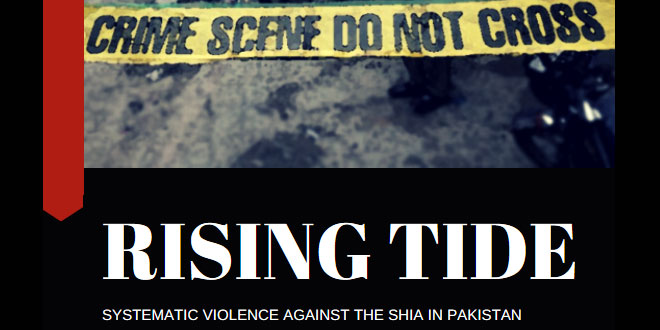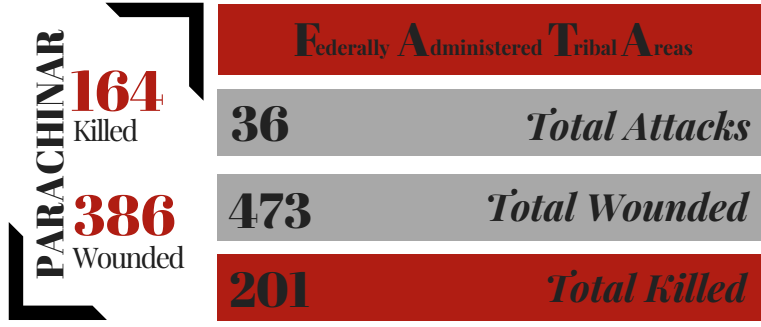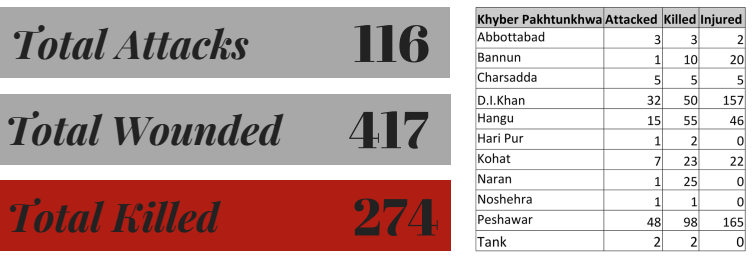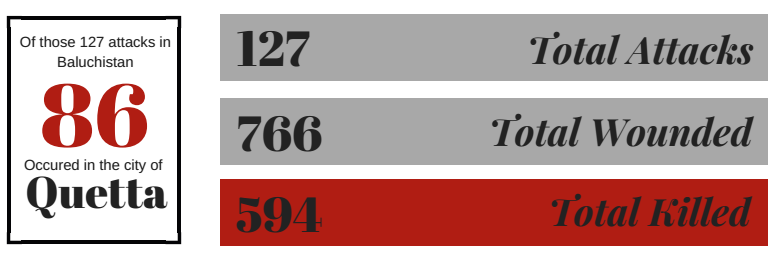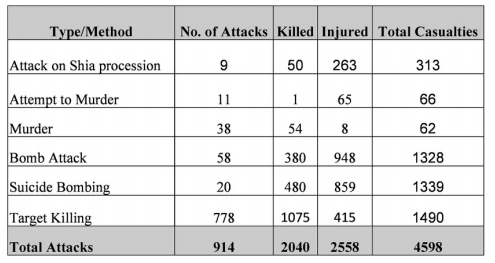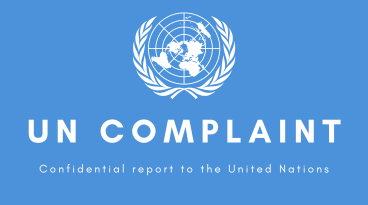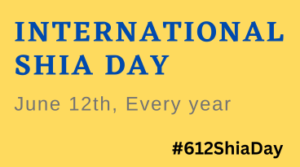The Shia Rights Watch report entitled “Rising Tide” is 18 pages, detailing incidents of violence and intimidation against Pakistani Shia Muslims between 2012 and 2016.The report gives a detailed account of how this already oppressed group has been marginalized further in recent years through systematic violence and lack of protection. At least 914 attacks and 4,598 killing or wounding is reported. The report is based on interviews, site visits, articles, NGO reports, and other human rights reports. articles, NGO reports, and other human rights reports.
Download Printing Version HERE
Pakistan
Pakistan, officially the Islamic Republic of Pakistan Islāmī Jumhūriya-ē Pākistān, is a country in South Asia. With a population exceeding 180 million people, it is the sixth most populous country in the world. Pakistan is a federal parliamentary republic consisting of four provinces and four federal territories. Pakistan is a federation of four provinces: Punjab, Sindh, Khyber Pakhtunkhwa, and Balochistan, as well as the Islamabad Capital Territory and the Federally Administered Tribal Areas in the northwest, which include the Frontier Regions. The government of Pakistan exercises de facto jurisdiction over the western parts of the disputed Kashmir region, organized into the separate political entities Azad Kashmir and Gilgit–Baltistan (formerly Northern Areas). The Gilgit–Baltistan Empowerment and Self- Governance Order of 2009 assigned a province- like status to the latter, giving it self-government.
The state religion in Pakistan is Islam, which is practiced by about 95-98% of the 180 million people of the nation. The remaining 2-5% practice Christianity, Hinduism, and other religions. Muslims are divided into two major sects: the majority of them practice Sunni Islam, while the Shias are a minority who make up an estimated 5-20%.
Pakistan is suffering a major crisis, in which terrorist groups are continuously committing mass events of violence against Pakistani Shia Muslims.
Terrorist organizations mostly target Shia scholars, activists or those who have senior positions. This report aims to highlight some of the attacks and killings in the country and emphasize the urgent need for change in the Pakistan. Shia Rights Watch (SRW) urges the government of Pakistan should follow up on public denunciations of sectarian killings by securing Shia areas, controlling gun possession, and ordering the immediate arrest and prosecution of the leadership of the terrorist groups, their members, and affiliates responsible for planning systematic violence.
Casualties
Local Pakistani activists have recorded 914 attacks in different locations of Shia-populated areas of Pakistan between 2012 and 2016. Such attacks resulted in the death of at least 2,040 and injury of 2,558 Shia Muslims. The reporters were unable to follow up on the health status of the injured victims due to lack of resources and security limitations. There is also no report on damages due to explosions and targeted killings, but SRW expects significant damage to properties as a result of bombings and attacks. In other words, at least 4,598 people have been reported killed or wounded. Statistics suggest on average, three Shia are either killed or wounded daily due to Shia rights violations in Pakistan alone. In most cases of Pakistan attacks, those three happen to be Shia professionals.
It is important to highlight, this report only included cases that could be fact checked. SRW believes there are more cases that are not reported due to insecurities of Shia population.
Change in Social Structure
Explosions and bombings, in particular, are usually analyzed based on their casualty impacts. However, SRW believes more in-depth and holistic approaches are needed in order to be fair to victims of human rights violations. Explosions not only kill and wound, but they also damage homes, destroy businesses and shops, and destruct inventories, resulting in significant damages, affecting the economic structure of the society. In addition to economic effects, such incidents create a sense of insecurity. Insecurity results in a lack of motivation to take economic risks, desire for growth, fear of social involvements and even isolation.
SRW is concerned about Pakistani Shia community as they face so much discrimination which results in not only loss of life, but social distractions. As this report, and most other reports on Pakistani Shia highlight, many attacks in Pakistan are in the form of targeted killings. The victims of targeted killings are professionals: doctors, professors, businessmen, and influential lawyers. Targeting the social and political elite allows terror organizations to instill fear into society. The lack of prosecution in Shia deaths empowers terror groups and reinforces their ability to isolate groups within the larger society.
Lasting Effects
Anti-Shiism in Pakistan is estimated to change social dynamics. Data reports the majority of Shia killed are male heads of families whose death leave children without fathers and households without income. SRW estimates a rise in populations in need of welfare in the near future as a result of anti-Shiism. Further, SRW hypothesizes a rise in women and children in the workforce to make up for the lack of income. Children will begin working at a younger age and the nation will have a reduction in education rates.
Terror Organizations
The South Asian Terrorism Portal reports 12 different terror groups operating in Pakistan. The largest and most influential of the organizations are Lashkar-e-Jhangvi, Sipah-e- Sahaba, and Tehreek-e- Taliban. United States’ Bureau of Counterterrorism identified these three groups as foreign terrorist organization.
Tekree-e-Taliban, based in Western Pakistan, aims to establish an “Islamic Emirate.” Their specialties include IEDs, suicide attacks, mass casualty bombings, mortars, rockets, assassinations, kidnappings, executions, raids, assaults, and internet operations. Like Jundullah, Tehreek-e-Taliban is a subset of the Afghan Taliban and derives much of its resources from the Taliban.
Terrorism
Lashkare Jhangvi (LeJ) is one of the more active terrorist organizations in Pakistan. They’re into IEDs, assassinations, suicide attacks, mortars, grenades, rockets, and raids. LeJ’s ability to collaborate with larger radical organizations makes it highly influential. In an interview with Reuters, Ali bin Sufyan, LeJ al- Alami spokesperson said, “Wherever there are attacks taking place [in Pakistan] Lashkar-e-Jhangvi al-Alami is cooperating with [ISIS] either directly or indirectly.” Significant funding flows from al-Qaeda and Arab states. Saudi Arabian money has been traced to organizations such as ISIS and al-Qaeda.
LeJ has joined much of its forces with IS-Khurasan, marginalizing not only Shias but their empaths. In the recent years, LeJ has refocused its demographics, now targeting youth in the early twenties with varying backgrounds but with the same supremacist ideology. Sources report recruitment is targeted to youth with technological fluency. LeJ recruits will frequently use social media to post their most recent kills, which adds to their marketing to gain funds from international extremist organizations.
Terror organizations have propaganda in the form magazines and websites that grant them excellent access to international funds. They roam free enough to openly issue death threats to Shias in local newspapers, describing them as “deserving of death.”
Violation Types
This report examines attacks in the form of bombs, murders, suicide bombings and targeted killings. The majority of attacks on Shia were in the form of targeted killings, specifically, drive- by shootings. In the regions of Sindh, Balochistan, Khyber Pukhtunkhwa and Punjab, Shia individuals were identified, localized and targeted at their businesses or on-route. Specifically, the Shia targeted were individuals significant to their society. Educated doctors, lawyers, and more importantly, government officials were isolated and killed. Frequently targeted shootings that have little prosecution point to a structural and social violence against Shia Muslims.
The majority of attacks occurred in the daytime which points to a lack of fear from authorities and the surrounding community. Violators do not think they will be prosecuted for their ill actions because there is a social consensus that the Shia are second- class members of their community because of their belief systems. The region of FATA remains unique in the data as 80% of attacks occurred in the form of a bomb.
Major Regions
The aforementioned regions are areas of increased violence against Shia Muslims in descending order. It is important to note these regions have been isolated per acquired SRW data. Although each region has its own uniqueness in culture, similar anti- Shiism trends can be seen.
Anti-Shiism is made possible by regional instability. Lack of border security makes it easy for insurgents from other nations to flow into Pakistan and cause civil unrest. With them, insurgents bring education and anti- Shia propaganda that infiltrates Pakistani grassroots. That, in addition to money made by opioid and counterfeit trafficking, makes terrorism flourish.
Sindh
In recent years, the region of Sindh has been home to the most Shia deaths. Locally known as Mehran, Sindh is located in Southern Pakistan and is centralizes on Karachi. Once home to Muhajirs, migrants from neighboring nations, Sindh has developed a unique religious culture of its own, as a melting pot of the nation’s largest Hindu population. This Hindu-Islamic mix has given rise to the Sufi religion, which shares aspects of each of the two religions.
From 2012 to 2016, Sindh has been home to over 58% of incidents of anti-Shiism. Of the 530 deaths, 481 of the deaths were the result of targeted killings. Despite the region’s diversity in population, Shia Muslims are targeted. The nature of deaths points to a system of identification of Shia Muslims and their businesses/homes in a community. Further, the freedom for an individual to shoot another individual in a crowded area without fear of recognition and prosecution points to a social acceptance of anti-Shiism.
Baluchistan
In addition to sharing a border, Sindh and Baluchistan share high rates of Shia targeting. Baluchistan in the home to the Hazara population of Pakistan. Originally, the Hazara’s fled Afghanistan’s persecution and sought refuge in Quetta, Baluchistan’s capital city. Political unrest and lack of sufficient government action leave room for extremist groups to thrive.
Historically, the Hazara’s have been in support of the federal government and have a positive track record in maintaining loyalty to the nation. That, in addition to the region’s immense natural resource reservoirs, makes Baluchistan a location of significance. Located on the border of Afghanistan and Iran, Baluchistan is a key strategic region.
Mass targeting of the Shia population in Baluchistan has sparked a new wave of protests. However, despite the government’s initial promises to address anti-Shiism in Pakistan, few long-term changes have been made. Terror organizations continue to thrive economically and socially. So why are so many Shia’s being targeted in Baluchistan? The lack of modern development in this region makes it a fertile ground for insurgents to prosper. Development is further limited as terror organizations target individuals rising to power in any sector. Baluchistan is the home to the second most incidents of anti- Shiism. In a five-year period, there have been 127 incidents of anti-Shiism. The majority of incidents have been in the form of targeted shooting.
Khyber Pakhtunkhwa
Located in the northwestern region of Pakistan, Khyber Pakhtunkhwa is home to 12% of Pakistan’s population. The region makes up 10.5% of the nation’s economy despite being one of the geographically smaller areas. Inhabitants of this region are mainly Pashtun, followed by Tajiks and Hazaras. While small communities of Hindus and Christians exist, Islam is prominent in Khyber Pakhtunkhwa. Shia Muslims consist of a minority population – some of them Ismaili.
War and regional instability have left this region as a hub for the militant insurgency. As the region borders Afghanistan, Taliban influence flows through the area. Khyber Pakhtunkhwa is home to 13% of Pakistan’s overall incidents of anti-Shiism, resulting in the death of 274.
F.A.T.A
In late 2001, the terror organization Tehreek-e- Taliban entered the FATA region, creating an array of unrest. Gradually, the Taliban has increased its influence in the region. Adding to the instability of the region is poverty. Despite the area’s reservoirs of marble, copper, limestone, and coal, increased mistrust among government/non-government organizations and regional leaders makes retrieval of resources very difficult. Economic hardships and the uncontrolled movement from the Afghan border has created a market for opioids and contraband trafficking.
There have been 36 Shia deaths in the past five years. In contrast to other regions of Pakistan, FATA has a high rate of bomb attacks targeted at Shia populated areas.
Punjab
Punjab is the second largest area and most populated region after Baluchistan. In comparison to Baluchistan, however, Punjab is one of Pakistan’s most economically prosperous regions. Over 95% of Punjab is Muslim, the majority being Hanafi Sunni and a small minority of Shia Twelvers. Sufism is prominent in Punjab as well. Punjab
In the time period between 2012 and 2016, 158 Shia Muslims have lost their lives to targeted shootings, murder, and suicide bombing. In addition to Sindh, Punjab is home to the nation’s higher rates of attacks on Shia processions.
Gilgit Baltistan
Gilgit-Baltistan is the northernmost region of Pakistan. For years, Pakistan and India have disputed over the region as it can be the perfect input into Kashmir because of its mountainous foray. With a population of more than 1.5 million, Gilgit-Baltistan is one of Pakistan’s most heavily Shia populated areas. This area is of significant geopolitical interest as it allows a pathway to China, Afghanistan, Tajikistan, and India.
This region is home to 23 total attacks on Shia Muslims. The majority of those attacks were targeted shootings.
Civil Divide
A Pew Research Center survey taken in 2012 reveals the environment in which religious divides grew in Pakistan. According to the study, which took a sample of 1,450 Pakistanis, 35% reported that they did not consider Shias to be Muslim. Of the 35% mentioned, 50% of Sunnis viewed Shia as non-Muslims. This staggering number is dangerous considering the fact that blasphemy is still illegal in Pakistan. Outward blasphemy may result in death by the mob, as happened in April 2017 when a student was beaten to death by a mob after he questioned the Quran’s teachings on Adam and Eve. According to the Pew survey, 73% of Pakistanis believe in the Blasphemy Laws. Of those questioned, 5% believe that the Blasphemy Laws are geared toward singling out minorities. This 5% consists heavily of Shia and educated Sunnis.
The Pakistani government seems to avoid taking sides in the religious divide, and some politicians have even taken advantage of the conflict. According to the Center for Security Studies, due to these intolerant leaders being local enforcers, the politicians use them to rake in support from the leaders’ respective region. However, in 2014, Taliban militants entered an army-run school, killing 141 people, 132 of which were children. This led to the National Action Plan (NAP), which was a 30-point strategy through which the government would crack down on religious violence including provisions such as special trial courts under the supervision of the army and the stopping of militant outfits and armed gangs within the country.
From 2014 to 2016, 430 people had been executed. This number may seem daunting, but it is undermined by the fact that 80% had no connection to terrorism, and hate speech and literature has not stopped flowing into the public. Even politicians remain unhindered. In 2016, the Pakistani Interior Minister was criticized for meeting officially with an intolerant leader. When questioned, he undermined the NAP and government efforts by stating that the intolerant leader was not a terrorist. Though there has been a drop in violence, the Pakistani government doesn’t seem serious about total religious reconciliation. The Blasphemy Laws, fundamentalist groups, and general intolerance against Shia minorities will keep the religious violence in Pakistan a recurring issue.
Conclusion
As a result of the data obtained of cases of anti-Shiism in Pakistan in 2012-2016, Shia Rights Watch concludes that violations were with the goal of suppressing the power of the Shia community within the larger society by creating fear. While Shia Muslims strive to be a part of their society, extremist organizations aim to limit their social and political involvement. Further, by targeting prominent members of the community, terror organizations create social anxiety, which they hope will suppress the growth of the community by forcing them into hiding. With their actions, terror groups aim to marginalize the Shia identity.
Shia Rights Watch condemns acts of violence against Shia Muslims and all other minority groups. SRW calls on Pakistani authority to hold violators of human rights accountable for their action through just and fair trials. Areas of Pakistan inhabited by Shia Muslims are rich in resources and are strategic openings to neighboring nations. The instability created by extremist organizations have made the retrieval of resources impossible. Increasing security and involving Shia individuals in community building would reduce instability and allow for use to resources in those areas.
History of anti-Shiism in Pakistan has shown that the Shia population is resilient in nature. SRW hypothesizes not a reduction in the population of Shia in Pakistan, but an increase of Shia push for equal rights.



